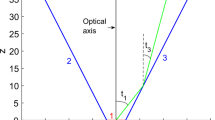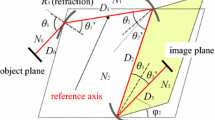Abstract
Although conventional 2×2 ray matrices, i.e. ABCD matrices, provide a convenient means of obtaining initial estimates of the performance of an optical system during the early stages of the design process, they are suitable only for optical systems with the axisymmetric property. Accordingly, this study utilizes the 6×6 matrix formalism, which was proposed by our group, for optical boundary surfaces to develop a new approach for modeling and analyzing 3D optical systems comprising multiple lenses and/or mirrors and clarifying many of the system’s basic properties, e.g. the effective focal length, primary aberration and cardinal points, and so forth. To reduce the complexity of the modeling process, general matrix formalisms of sub-systems in a 3D optical system are presented. The validity of the proposed approach is evaluated by modeling and analyzing a simple 3D optical system and comparing the results with those obtained from the skew ray-tracing computer program and commercial optical design software. The results confirm that the proposed methodology provides a convenient means of obtaining initial insights into a variety of 3D optical systems with non-coplanar axes.
Similar content being viewed by others
References
W. Brower, Matrix Method in Optical Instrument Design (Benjamin, Elmsford, 1964)
A. Gerrad, J.M. Burch, Introduction to Matrix Method in Optics (Wiley, New York, 1975)
S. Wang, D. Zhao, Matrix Optics (Springer, Berlin, 2000)
M. Nazarathy, J. Shamir, J. Opt. Soc. Am. 72, 356 (1982)
B. Macukow, H.H. Arsenault, J. Opt. Soc. Am. 73, 1360 (1983)
L.W. Casperson, J. Appl. Opt. 20, 2243 (1981)
A.A. Tovar, L.W. Casperson, J. Opt. Soc. Am. A 14, 882 (1997)
A.E. Attard, J. Appl. Opt. 23, 2706 (1984)
J.A. Rodrigo, T. Alieva, M.L. Calvo, J. Opt. Soc. Am. A 23, 2494 (2006)
C.Y. Tsai, P.D. Lin, Appl. Phys. B 91, 105 (2008)
L. Agrawal, A. Bhardwaj, S. Pal, A. Kumar, Appl. Phys. B 89, 349 (2007)
T. Hansel, J. Müller, C. Falldorf, C. Von Kopylow, W. Jüptner, R. Grunwald, G. Steinmeyer, U. Griebner, Appl. Phys. B 89, 513 (2007)
P.D. Lin, C.-K. Sung, OPTIK 117, 329 (2006)
Author information
Authors and Affiliations
Corresponding author
Rights and permissions
About this article
Cite this article
Lin, PD., Hsueh, CC. 6×6 matrix formalism of optical elements for modeling and analyzing 3D optical systems. Appl. Phys. B 97, 135–143 (2009). https://doi.org/10.1007/s00340-009-3616-7
Received:
Revised:
Published:
Issue Date:
DOI: https://doi.org/10.1007/s00340-009-3616-7




